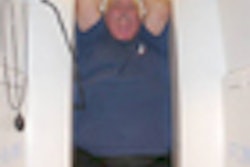Computer-aided detection (CAD) technology can significantly improve the overall performance of radiologists in detecting lung nodules, but it may not provide a statistically significant difference for detecting more lung cancer, according to research published in the Journal of Computer Assisted Tomography.
"The use of CAD, however, contributed to the detection of additional lung cancers for less experienced readers," wrote a research team led by Dr. Jin Mo Goo of Seoul National University College of Medicine in South Korea.
Seeking to determine the impact of a CAD system on the performance of observers for the detection of both lung nodules and lung cancers, the researchers retrospectively reviewed 150 consecutive CT scans with a section thickness of 3.2 mm or less. Inclusion criteria allowed cases with histologically proven lung cancer less than 2 cm in diameter, cases with lung nodules that were stable for at least two years, or cases without lung nodules (J Comput Assist Tomogr, August/September 2008, Vol. 32:4, pp. 570-575).
The researchers selected 150 studies to simulate a scenario in which 30 CT scans a day were read by a radiologist for five days. Twenty-three lung cancers (15 adenocarcinomas, seven bronchioloalveolar carcinomas, and one non-small cell lung cancer in which specific cell type was not determined on biopsy) in 22 patients were included, according to the authors. In addition, one patient had two lung cancers.
Mean size of these 23 lung cancers was 12.6 mm ± 3.4 (range, 5-18 mm). Two radiologists classified the lung cancers in consensus as one pure ground-glass opacity (GGO) (nonsolid), 12 mixed GGO (part solid), and 10 solid.
An additional five board-certified radiologists with a range of five to 12 years of thoracic CT interpretation experience and five radiology residents (two third-year and three fourth-year residents) then participated in the observer performance study. Clinical, demographic, or database information was not available to the radiologists, who first read the cases without CAD and then with the CAD results. The observer performances were then compared using a jackknife free-response receiver operating characteristic (JAFROC) analysis.
The CAD system detected 726 nodule candidates, 282 of which were true-positives. Overall, CAD sensitivity was 80%, with a false-positive rate of 2.96 per case. The reader-averaged values for all observers, the radiologist group, and the resident group were 0.69, 0.71, and 0.68 without CAD and 0.78, 0.79, and 0.77 with CAD, according to the authors.
From the JAFROC analysis, the researchers found the differences between without and with CAD to be statistically significant in all observers (F = 47.4, p < 0.001), the radiologist group (F = 44.5, p < 0.001), and the resident group (F = 36.2, p < 0.001).
"Although the overall performance of detecting lung cancers was not affected significantly with the use of CAD (p > 0.05), 4 lung cancers missed by 3 residents on their initial observation were additionally detected with CAD," the authors wrote. "Eighteen of 23 lung cancers were detected by CAD itself."
CAD missed two solid nodules, two mixed GGOs, and one pure GGO.
The researchers acknowledged several limitations of their study, including its retrospective nature and that it was performed in a laboratory setting. Also, there were too many cancers and lung nodules for what would be expected over a five-day reading period, according to the authors.
Nonetheless, the CAD scheme did yield significantly higher detection of lung nodules, albeit without an overall statistically significant difference in the detection of lung cancer, according to the researchers.
"A CAD scheme designed to detect both solid and GGO nodules and to characterize detected nodules would improve the identification of additional lung cancers," the authors wrote.
By Erik L. Ridley
AuntMinnie.com staff writer
September 24, 2008
Related Reading
CAD steals show from U.S. research database, August 12, 2008
CT databases aimed at lung imaging research, August 8, 2008
CAD helps residents identify lung nodules on DR, May 20, 2008
Criteria determine CAD mark sensitivity, March 20, 2008
Experience may make a difference with lung CAD, February 4, 2008
Copyright © 2008 AuntMinnie.com





















